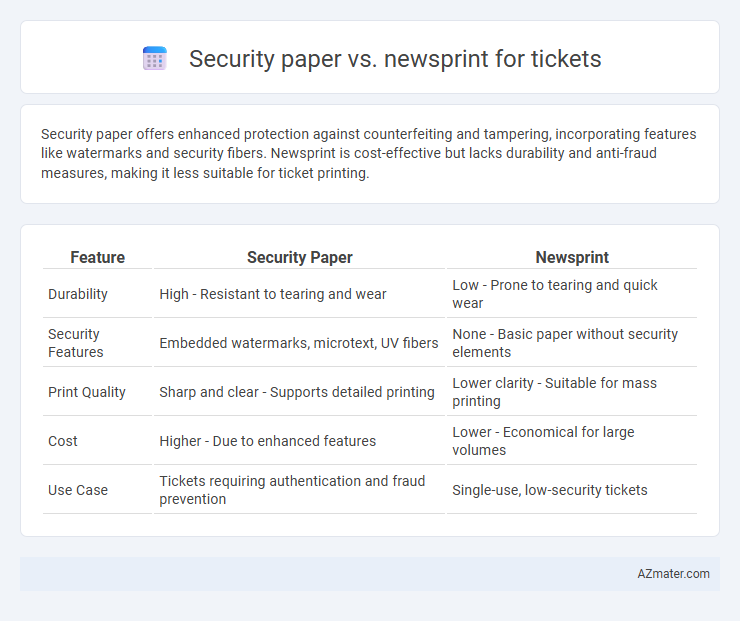Security paper offers enhanced protection against counterfeiting and tampering, incorporating features like watermarks and security fibers. Newsprint is cost-effective but lacks durability and anti-fraud measures, making it less suitable for ticket printing.
Table of Comparison
| Feature | Security Paper | Newsprint |
|---|---|---|
| Durability | High - Resistant to tearing and wear | Low - Prone to tearing and quick wear |
| Security Features | Embedded watermarks, microtext, UV fibers | None - Basic paper without security elements |
| Print Quality | Sharp and clear - Supports detailed printing | Lower clarity - Suitable for mass printing |
| Cost | Higher - Due to enhanced features | Lower - Economical for large volumes |
| Use Case | Tickets requiring authentication and fraud prevention | Single-use, low-security tickets |
Understanding Security Paper and Newsprint
Security paper features embedded watermarks, fibers, and anti-copy patterns designed to prevent counterfeiting, making it ideal for printing tickets requiring high fraud resistance. Newsprint, a low-cost, uncoated paper made from wood pulp, lacks security elements and is prone to easy duplication, limiting its use in secure ticketing applications. Understanding these material differences is crucial for selecting the appropriate substrate for tickets based on durability, cost, and security needs.
Key Differences in Material Composition
Security paper for tickets incorporates embedded fibers, watermarks, and microprinting, enhancing fraud prevention and durability. Newsprint is made from inexpensive, low-quality wood pulp with high lignin content, resulting in a porous, lightweight, and easily degradable material. The primary difference lies in security paper's specialized coatings and additives that improve tensile strength and resistance to tampering, unlike the basic, uncoated structure of newsprint.
Why Security Paper Enhances Ticket Fraud Prevention
Security paper enhances ticket fraud prevention by incorporating advanced features such as watermarks, microprinting, and embedded fibers that are difficult to replicate or alter, increasing the difficulty for counterfeiters. Unlike newsprint, which lacks these specialized security elements and is prone to easy duplication, security paper provides a robust physical barrier against forgery. The use of security paper in ticket production ensures higher authenticity verification, reducing fraud-related losses and enhancing event security protocols.
Cost Comparison: Security Paper vs Newsprint
Security paper costs significantly more than newsprint due to its specialized features like watermarks, embedded fibers, and anti-counterfeiting technology essential for tickets. Newsprint, being a low-cost, uncoated paper primarily made from recycled fibers, offers economical advantages but lacks durability and security measures. For ticket production, the higher price of security paper is justified by enhanced protection against fraud, whereas newsprint suits budget-friendly, short-term use cases without security concerns.
Print Quality and Durability Considerations
Security paper offers enhanced print quality with sharp, clear text and vibrant colors due to its specialized coatings, making it ideal for tickets requiring detailed logos and barcodes. It provides superior durability against fading, tearing, and moisture, ensuring the ticket remains intact and legible throughout its lifecycle. Newsprint, while cost-effective, tends to absorb ink unevenly and is prone to quick deterioration, compromising both print clarity and longevity in ticket applications.
Security Features Unique to Security Paper
Security paper for tickets incorporates advanced anti-counterfeit features such as watermarks, security fibers, microprinting, and heat-sensitive inks that are absent in standard newsprint, significantly reducing forgery risks. Embedded security threads and tactile elements enhance authentication and enable easy verification by event staff. These specialized elements ensure ticket integrity and protect revenue by preventing duplication and unauthorized reproduction.
Environmental Impact of Security Paper and Newsprint
Security paper typically incorporates fibers and coatings designed to prevent counterfeiting, often requiring additional chemical treatments that can increase environmental impact during production and disposal. Newsprint is generally made from recycled paper with less intensive processing, resulting in lower energy consumption and reduced chemical use, making it a more environmentally friendly option for short-term documents like tickets. However, the durability and security features of security paper may reduce waste by minimizing fraudulent reprints, balancing some environmental concerns depending on the application.
Optimal Use Cases for Security Paper Tickets
Security paper is ideal for tickets requiring enhanced protection against counterfeiting, featuring embedded fibers, watermarks, and holograms that ensure authenticity and prevent fraud. Newsprint, being low-cost and less durable, suits high-volume events with short-term use where anti-counterfeit measures are less critical. Tickets for concerts, sports events, or transportation benefit from security paper to safeguard access control and maintain trust in ticket validity.
Choosing the Right Paper Based on Event Needs
Security paper offers advanced features such as watermarks, microtext, and UV-reactive elements, making it ideal for high-profile or large-scale events requiring fraud prevention and ticket authenticity. Newsprint, being cost-effective and lightweight, suits smaller, short-term events where budget constraints are paramount and security concerns are minimal. Selecting the appropriate paper hinges on balancing event size, budget, and the necessity for anti-counterfeit measures.
Expert Recommendations for Ticket Printing
Security paper is highly recommended by experts for ticket printing due to its enhanced fraud prevention features such as watermarks, microtext, and tamper-evident elements, ensuring authenticity and reducing counterfeit risks. Newsprint, being low-cost and easily accessible, lacks these protective qualities, making it unsuitable for high-security ticket applications where accuracy and trustworthiness are critical. Industry specialists advise prioritizing security paper for event, transportation, or raffle tickets to maintain integrity and safeguard revenue streams.

Infographic: Security paper vs Newsprint for Ticket
 azmater.com
azmater.com